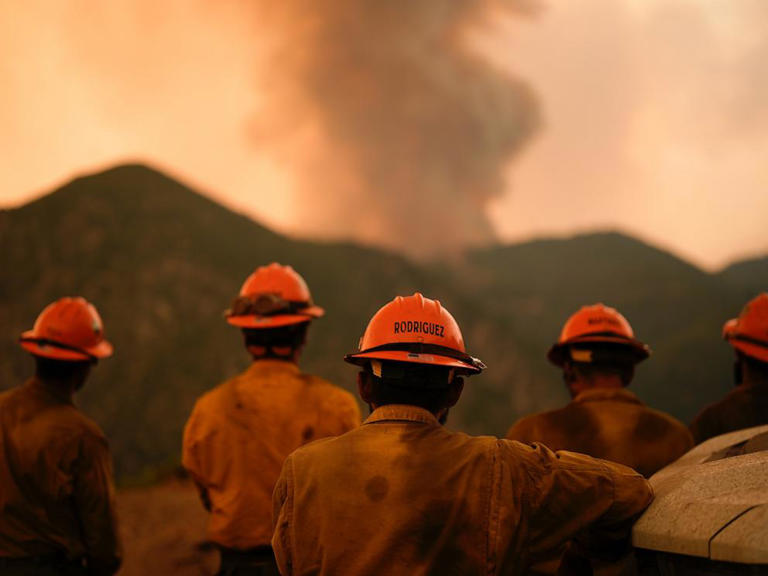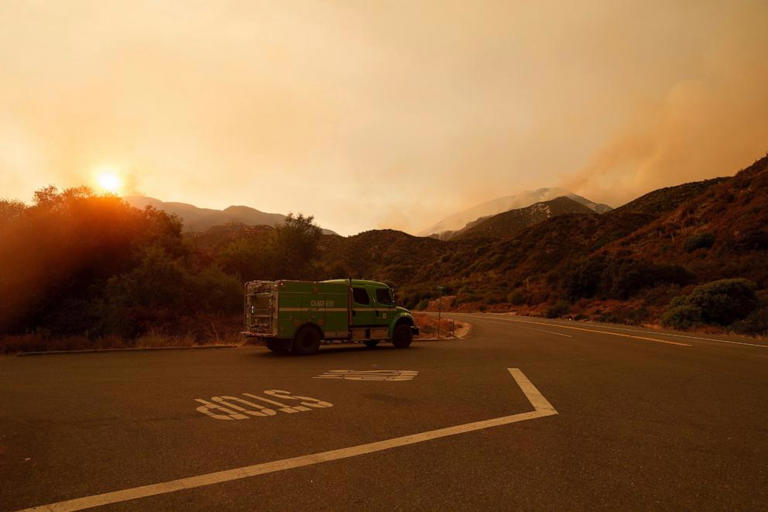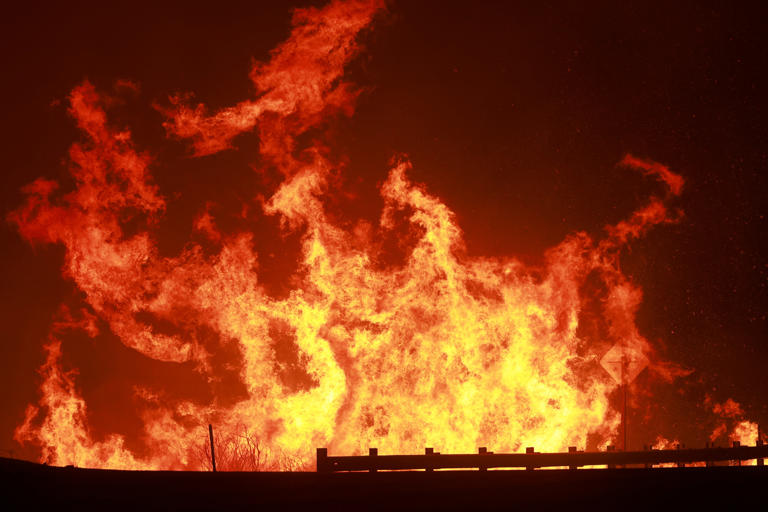Credit ABC News
On Monday night, the Southern California Line Fire was only 5% contained by fire brigades, with 23,714 acres burned.
According to Cal Fire’s most recent report, 38,002 structures were threatened by the wildfire in San Bernardino County, east of Los Angeles. However, the report also said that there were no damages to buildings or casualties other than the three firefighters already injured.
According to Governor Gavin Newsom’s Monday announcement, the California National Guard will assist in the current response to the Line Fire, the cause of which is still under investigation.

Members of the Mill Creek Hotshots monitor the Line Fire near Angelus Oaks, California, Monday, Sept. 9, 2024.
© Gregory Bull/AP
The California National Guard has been sent in to help fight the continuous wildfires that are raging across the state, turning entire neighbourhoods into ashes and evacuating hundreds of people. The state’s fire season has reached a horrifying crescendo, scorching over acres and driving communities to the verge of fatigue and hopelessness. The National Guard’s entrance amid this mayhem provides resources, personnel, and hope—all of which are critically needed to put out the fire.
Human casualties from wildfires
“We’re pouring resources into this incident aggressively by deploying more air and ground support through the California National Guard,” Newsom said in a statement. “We already have close to 2,000 firefighters, 200 engines, and aircraft fighting this fire; this is on top of that. California has these communities’ backs and stands with them.”
The wildfire’s north and east flanks witnessed the most activity on Monday, according to Cal Fire, which also stated that “the fire could remain active overnight as vegetation remains critically dry.”
Beloved homes were destroyed, livelihoods reduced to ashes, and families torn apart. A faded family portrait was among the few belongings Maria Gutierrez, a mother of three, was able to save before the fire completely destroyed her home in Sonoma County. “I just had a few minutes,” she recalls, as tears streamed down her cheeks. “We grabbed whatever we could and ran. The fire was moving fast.
Maria is not alone in her story. California’s wildfires have already forced more than 100 residents to evacuate, disrupting businesses and leaving townspeople worried about the future. Some see the fires as a symbol of the destruction of a lifetime of memories, not just property loss. Stories like Maria’s are told across California, each one highlighting the terrible cost these fires have taken.
An Exhausted Front Line of Protection
Thousands of firefighters have been deployed by the California Department of Forestry and Fire Protection (Cal Fire), but the size of the fire has left resources stretched thin. First responders are working tirelessly and braving dangerous conditions to save lives and property. Dry vegetation and strong winds are causing the fire to spread more rapidly than in previous years, making control operations more difficult.
“The heat is unbearable, and the smoke is thick. We’re exhausted, but we’ll keep trying. We have to try,” says John Harper, who has been on the front lines for nearly two weeks.
The National Guard: A Vital Reinforcement

Firefighters monitor the advancing Line Fire in Mentone, Calif., Monday, Sept. 9, 2024.© Eric Thayer/AP
Recognizing the urgent need for additional assistance, the state has called on the California National Guard. The Guard has deployed more than soldiers, engineers, and air support units to provide critical assistance in areas most affected by the fires. Their mission includes everything from clearing firebreaks and evacuating residents to delivering supplies and providing logistical support.
Major General David Baldwin, adjutant general of the California National Guard, explains, “Our primary goal is to support local agencies and bring our special capabilities to the table. We are here to protect the people of California and make sure every possible resource is used to bring these fires under control.”
National Guard helicopters equipped with water buckets have been game-changers, targeting hard-to-reach areas and dousing flames that would otherwise continue to spread. Engineers are also working tirelessly to create firebreaks, which help prevent the fires from advancing into populated areas.
The science behind the flames

Highway 330 is engulfed by the flames of the Line Fire near Running Springs, California, on September 7, 2024. California Governor Gavin Newsom and San Bernardino County authorities declared a state of emergency on September 8.© DAVID SWANSON/AFP/GETTY
Many variables are contributing to California’s wildfire problem, including climate change, prolonged drought, and increased urban development in fire-prone areas. Scientists blame changing weather patterns and rising global temperatures for the magnitude and frequency of wildfires.
Dr. Emily Thompson, a scientist who studies climate change at the University of California, Berkeley, argues that “climate change is a real and present danger that is manifesting itself through these fires.” “We are seeing a new normal with longer fire seasons, more intense fire behavior, and greater threats to property and human life.”
Resilient communities: A beacon of hope
Amid the devastation, stories of community resilience have emerged as a ray of hope. Local residents have come together to support one another, donating food, clothing, and essentials to those who have lost everything. Volunteers like James Sullivan, a retired teacher, have been working tirelessly at evacuation centers, offering solace and guidance to the displaced.
“I couldn’t just sit back and watch,” says James. “These are my neighbors, my friends. We have to stand together and help each other during this difficult time.”
Social media has also played a key role in coordinating relief efforts. Local organizations are using platforms like Twitter and Facebook to broadcast real-time updates, organize volunteers, and collect donations. Many have opened their homes to those in need, reinforcing a sense of unity and community that has become so essential in these difficult times.
The Way Ahead: Difficulties and Hope
People are realizing that California’s wildfire seasons are getting more dangerous and unpredictable as the fires rage on. In order to prevent catastrophic disasters in the future, experts advise taking a multifaceted approach that includes stronger state and federal climate action in addition to better forest management and infrastructure upgrades.
“We have to adapt,” said Governor Gavin Newsom, urging more financing and assistance for fire safety programs. It is essential to our future and the security of our communities.” The resilience that characterizes California is best exemplified by the actions of the California National Guard, Cal Fire, local firemen, and regular citizens. The will to rebuild and recover is stronger than ever, despite the difficult road ahead.
In summary, united against fire
There is a newfound sense of hope and unity in California as it battles one of the hardest fire seasons in its history thanks to the National Guard’s presence. Though the fight is far from done, Californians are demonstrating that, united, they can withstand any adversity with every drop of rain, every path cleared, and every act of kindness.




